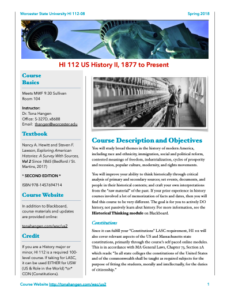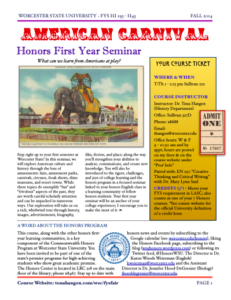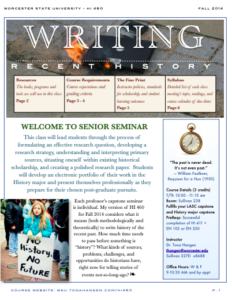Some years ago, I found that course and syllabus design were two of my professorial responsibilities that I most enjoyed, and they have since become a creative outlet for me. With a 4/4 teaching load, I have plenty of opportunities to experiment and improve (see all my past syllabi here).
In January 2011 I wrote a blog post detailing how I transformed the appearance and pedagogical design of my US History survey course, “Extreme Syllabus Makeover” (1/3/11). It got favorable mention in a ProfHacker post by Jason B. Jones, “Creative Approaches to the Syllabus” (8/26/11) and I later posted a similar version on the Teaching US History blog (TUSH.0, 8/22/12). I have presented workshops or conference sessions on course and/or syllabus design in multiple venues, including for the New England Faculty Development Consortium in 2011, Nichols College in 2012, Stonehill College in 2017, and at The Teaching Professor Conference (New Orleans) in 2019.
To digitally format and present my syllabi, I use stock newsletter templates in a standard installation of Pages for Mac. I save them as full-color PDF and upload to Flipsnack, where they can be linked to Blackboard or a course website as a Flash-player display (for example, a recent syllabus for the US Since 1945). I take my inspiration from magazine layouts, cookbooks, and blogs and try to avoid giant blocks of text. My aim is to reduce textual clutter, and instead give pared-down, readable, technologically savvy syllabi that suggest—at a glance—my personality and the approach of the course. Elegant syllabi in this format work well when printed, especially in color, or as digital documents.
Syllabus bloat is a real problem — there is no end to online think pieces lamenting the growing length, complexity, and contractual tone of contemporary higher ed syllabi, and you will (as I do) undoubtedly have ballooning expectations or required additions mandated from your own institution that you have to work with (or around).
Still, effective syllabus design reflects good course design. Good course design originates in thoughtful attention to what you want students to accomplish or learn (using precise and active verbs), with assignments, learning experiences, and assessment aligned to those goals. Every professor should be familiar with Wiggins and McTighe’s Understanding By Design and their “backwards design” model, as it applies to your own discipline. I’m convinced that syllabus design (and redesign) is a powerful, reflective pedagogical practice.
Need more? I’ve detailed my approach to course design in a 2012 blog series for the Juvenile Instructor, “Oz Behind the Curtain:” Part 1, Part 2, Part 3, and Part 4.



